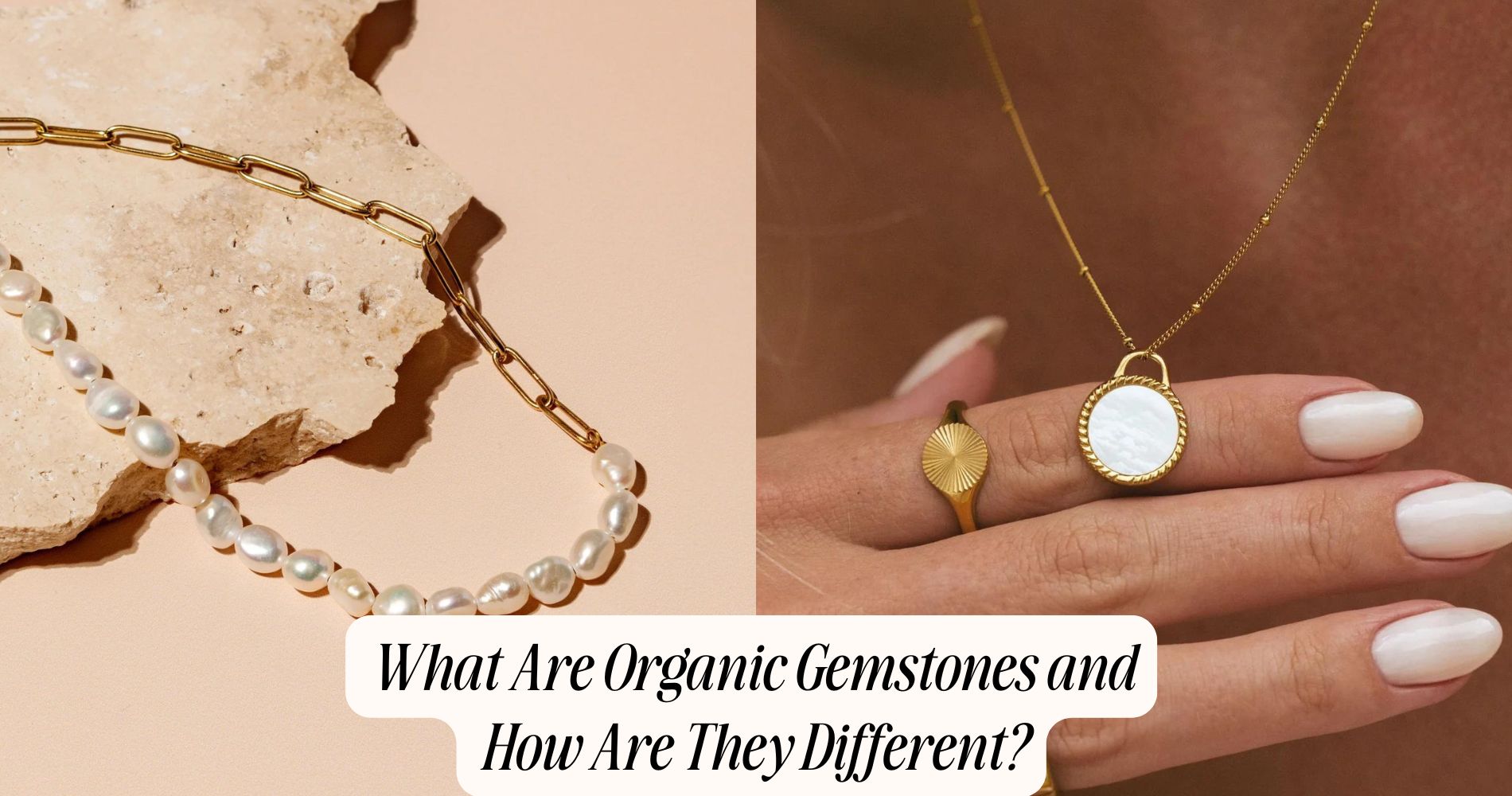
What Are Organic Gemstones and How Are They Different?
Organic gemstones, like amber and pearls, originate from biological processes rather than mineral formations. They develop from materials such as tree resin or mollusk secretions, showcasing unique characteristics tied to their biological origins. In contrast, mineral gemstones crystallize from geological processes. Organic gemstones often exhibit distinctive colors and textures, influenced by their environmental factors. While they may have a lower market value compared to rare minerals, their cultural significance and appeal in pearl necklaces and other jewelry designs remain substantial. Understanding these differences and their implications on aesthetics and value can enhance your appreciation of organic gemstones and their unique allure.
Definition of Organic Gemstones
When exploring the world of gemstones, it's essential to understand what defines organic gemstones. Unlike inorganic gemstones, which are primarily composed of minerals, organic gemstones originate from biological processes. They can be derived from plants or animals, and their formation often reflects a unique interplay between life and geology. Examples include amber, formed from tree resin, and pearls, which develop within mollusks.
The historical significance of organic gemstones can't be overstated. For centuries, cultures have utilized these gems in art, jewelry, and rituals, attributing them with various meanings and powers. This rich history adds layers of value that often transcend their physical properties.
Additionally, ethical sourcing of organic gemstones is becoming increasingly important in today's market. As consumers grow more conscious of the impact of their purchases, knowing the origins of these gems can greatly influence your buying decisions.
Ethical sourcing guarantees that these gemstones are obtained through environmentally sustainable practices and without exploiting labor. By prioritizing organic gemstones with clear ethical backgrounds, you contribute to a more responsible industry, promoting both ecological balance and fair trade practices.
Common Types of Organic Gemstones
Organic gemstones come in various forms, each showcasing a unique origin rooted in biological processes. Among the most notable types are amber and coral, both of which highlight distinct characteristics derived from their respective sources.
Amber originates from fossilized tree resin, primarily from coniferous trees. This process captures ancient organic materials, including insects and plant matter, thereby preserving a snapshot of the past. The value of amber lies not just in its beauty but also in its scientific significance, as it can provide insights into prehistoric ecosystems.
Coral formations, on the other hand, are created by the skeletal remains of marine organisms, particularly coral polyps. These tiny creatures secrete calcium carbonate, which accumulates over time, forming intricate structures that can grow into vast reefs.
The vibrant colors of coral gemstones stem from various pigments and the specific types of coral involved, making each piece unique.
Both amber and coral are prized not only for their aesthetic appeal but also for their fascinating origins, which reflect the interplay between living organisms and their environments.
Understanding these common types enhances your appreciation of organic gemstones and their place in the natural world.
Formation Processes
When you explore the formation processes of organic gemstones, you'll encounter their natural origins and the unique geological conditions that contribute to their development.
Each gemstone's formation is influenced by specific environmental factors, which dictate its characteristics and rarity.
Understanding these processes is essential for appreciating the value and uniqueness of these organic materials.
Natural Organic Origins
Gemstones with natural organic origins are formed through a variety of intricate processes that involve biological materials. These materials often come from living organisms such as plants, corals, and shells. Over time, these organic substances undergo significant alteration, leading to the creation of valuable gemstones.
For example, amber originates from tree resin, which hardens and fossilizes over millions of years, capturing ancient organisms in its embrace.
Fossil origins play an essential role in the formation of certain organic gemstones. Pearls, for instance, develop within mollusks as a defense mechanism against irritants. Layers of nacre, a combination of aragonite and conchiolin, accumulate around the irritant, resulting in a lustrous gem.
Similarly, jet, which is formed from decayed wood under specific pressure and temperature conditions, showcases the remarkable shift from organic material to gemstone.
Unique Geological Processes
The transformation of organic materials into gemstones involves unique geological processes that greatly influence their final characteristics. These processes begin with the biological origins of the materials, where organic matter, such as plant and animal remains, undergoes significant changes over time.
For instance, in the case of amber, tree resin accumulates, trapping insects and other debris. Over millions of years, heat and pressure lead to the polymerization of the resin, resulting in a durable gemstone.
Similarly, pearls form through a biological process in which mollusks secrete layers of nacre around irritants, ultimately producing a lustrous gemstone.
Fossilized materials, like jet, arise from decomposed wood that undergoes a series of geological transformations, including pressure and heat, resulting in a dense, coal-like substance.
These unique formation processes not only dictate the physical properties—such as hardness, color, and luster—but also the rarity and value of the gemstones.
Understanding these geological changes is essential for appreciating the intricate journey from organic origin to gemstone. Each type of organic gemstone tells a story shaped by its unique formation environment, revealing the complex interplay of biology and geology.
Comparison With Mineral Gemstones
When comparing organic gemstones to mineral gemstones, it's essential to understand their distinct formation processes and how these influence their physical properties.
You'll notice variations in durability, luster, and overall appearance that stem from their differing origins.
Additionally, the value and rarity of these gemstones reflect their unique characteristics, making for an intriguing analysis.
Formation Processes Explained
Organic gemstones and mineral gemstones undergo distinct formation processes that highlight their unique characteristics.
Organic gemstones, like amber and coral, originate from biological sources. For instance, amber forms from the fossilized resin of ancient trees, capturing insects and plant material over millions of years. Coral, on the other hand, is created by marine organisms that build calcium carbonate structures, eventually hardening into gemstone form. These processes often take thousands to millions of years, reflecting the slow accumulation of organic material.
In contrast, mineral gemstones, such as diamonds and sapphires, form through geological processes involving heat, pressure, and crystallization. These minerals crystallize from molten magma or through metamorphic changes in existing rocks. The inherent properties of these minerals contribute to their durability and brilliance, often linked to ancient uses in jewelry and symbolism in various cultures.
Both types of gemstones possess rich symbolic meanings; for example, amber is often associated with healing and protection, while sapphires symbolize wisdom and nobility.
Understanding these formation processes not only illuminates their origins but also enhances your appreciation of their historical significance and inherent beauty.
Physical Properties Comparison
Comparing the physical properties of organic gemstones with those of mineral gemstones reveals significant differences that impact their applications and aesthetic appeal.
Organic gemstones, such as amber and coral, exhibit unique color variations stemming from their biological origins. These hues can range widely, influenced by factors like the environment in which they formed. In contrast, mineral gemstones often display a more uniform coloration, dictated by their chemical composition and crystalline structure.
Texture differences further distinguish these two categories. Organic gemstones typically possess a more varied texture, showcasing natural imperfections like inclusions and patterns from their biological origins. For instance, the surface of a pearl is often smooth yet can have subtle irregularities that enhance its charm.
Mineral gemstones, while they can also present texture variations, usually exhibit a more polished and structured appearance due to their crystalline formations.
These physical properties not only influence the visual appeal of the gemstones but also affect their durability and usability in jewelry and decorative items.
Understanding these distinctions helps you appreciate the unique qualities of organic gemstones compared to their mineral counterparts.
Value and Rarity Differences
Value and rarity often play vital roles in determining the appeal of gemstones, and this is particularly evident when you examine organic gemstones alongside their mineral counterparts. Organic gemstones, such as pearls and amber, typically exhibit lower market values compared to rare mineral gemstones like diamonds or emeralds. This disparity stems from the varying degrees of scarcity; mineral gemstones often form under specific geological conditions that are uncommon, while organic gemstones arise from biological processes that can be more widespread.
When evaluating investment potential, mineral gemstones usually offer a more robust market trend, as their rarity drives demand and price stability. In contrast, organic gemstones can be more volatile, influenced by factors such as seasonal availability and changing consumer preferences.
However, certain organic gemstones, like high-quality coral or rare pearls, can still command significant prices, reflecting their unique qualities and limited supply.
Ultimately, understanding these value and rarity differences is vital for anyone looking to invest in gemstones. While both organic and mineral varieties hold appeal, the investment potential varies greatly, making it essential to stay informed about market trends specific to each category.
Uses in Jewelry Design
Many designers appreciate the unique qualities of organic gemstones in jewelry design due to their natural origins and distinctive characteristics. These materials, including pearls, coral, and amber, offer a range of textures and colors that can elevate any piece. When you incorporate organic gemstones into your designs, you're not just adding beauty; you're also utilizing specific design techniques that highlight their inherent qualities.
For instance, you might consider using a combination of polished and raw finishes to showcase the natural beauty of a gemstone like turquoise. This approach can enhance the aesthetic appeal of your jewelry, creating a striking contrast that draws the eye. Additionally, organic gemstones often feature unique patterns and inclusions that serve as conversation starters, making your designs stand out in a crowded market.
Furthermore, the lightweight nature of many organic gemstones can allow for innovative designs that prioritize comfort without sacrificing style. By understanding the properties of these gemstones, you can experiment with various settings and materials, ensuring that each piece not only looks great but also feels cohesive.
Ultimately, embracing organic gemstones can expand your design palette and elevate your craftsmanship.
Cultural Significance
While organic gemstones may be admired for their aesthetic appeal, their cultural significance can't be overlooked. Each gemstone carries profound cultural symbolism that transcends mere decoration.
For instance, coral has been revered in Mediterranean cultures for its supposed protective properties, often believed to ward off evil spirits. Similarly, pearls, formed within mollusks, symbolize purity and have historical significance in various societies, from royal adornments to bridal jewelry.
These gemstones frequently serve as tokens of status and identity, reflecting societal values and beliefs. In many Indigenous cultures, shells and amber are revered not only for their beauty but also for their connection to ancestral traditions.
The historical significance of organic gemstones is also notable; they often mark pivotal life events, such as births, marriages, and commemorations, reinforcing their role in human experience.
Understanding this cultural context enhances your appreciation of organic gemstones. By recognizing their historical significance and cultural symbolism, you can engage more meaningfully with these natural wonders, acknowledging the rich narratives they embody.
Ultimately, organic gemstones are more than just decorative items; they're intertwined with human history and cultural identity.
Care and Maintenance
Proper care and maintenance are essential for preserving the beauty and integrity of organic gemstones. To guarantee longevity, you need to implement effective cleaning techniques. Avoid harsh chemicals that can damage these delicate materials; instead, use a mild soap solution and a soft cloth or brush.
Rinse thoroughly with lukewarm water and dry gently to prevent moisture buildup. Regular cleaning can help maintain their luster while removing accumulated dirt.
When it comes to storage solutions, keep your organic gemstones in a cool, dry place away from direct sunlight. Use soft pouches or lined boxes to prevent scratches and damage from harder materials.
If you're stacking multiple pieces, make sure they're separated with soft fabric to minimize friction. Additionally, avoid storing your gemstones with jewelry made of metals or harder stones that could cause abrasions.
Frequently Asked Questions
Are Organic Gemstones Suitable for Everyday Wear?
Yes, organic gemstones can be suitable for everyday wear, but you should consider durability concerns. To maintain their appearance, follow specific maintenance tips like avoiding harsh chemicals and storing them properly to prevent scratches.
How Do Organic Gemstones Compare in Value to Mineral Gemstones?
When comparing organic gemstone valuation to mineral gemstone rarity, you'll find that organic gemstones often have lower market values due to their abundance, while mineral gemstones can command higher prices based on scarcity and demand factors.
Can Organic Gemstones Be Synthetic or Lab-Created?
Yes, organic gemstones can have synthetic origins. Lab processes can create materials mimicking organic stones, but the resulting products differ notably in composition, properties, and value compared to their natural counterparts, affecting their desirability.
What Are the Ethical Considerations Surrounding Organic Gemstones?
When considering organic gemstones, you should prioritize sustainability practices and sourcing transparency. Ethical sourcing guarantees minimal environmental impact and supports fair labor, allowing you to make informed choices that align with your values and promote responsible consumption.
How Can I Identify an Organic Gemstone?
To identify an organic gemstone, examine its color variations and texture. Research its historical significance, because this knowledge can help you differentiate it from synthetic or mineral-based gems, ensuring you make an informed choice.
Conclusion
In conclusion, organic gemstones, formed from biological processes, offer unique qualities distinct from mineral gemstones. Their diverse types, such as pearls and amber, showcase varied formation processes and cultural significance. When used in jewelry design, they add depth and history, while their care and maintenance require specific attention to preserve their integrity. Understanding the environmental impact of sourcing these gems is essential, ensuring sustainable practices that honor both nature and craftsmanship.

























Leave a comment
This site is protected by hCaptcha and the hCaptcha Privacy Policy and Terms of Service apply.